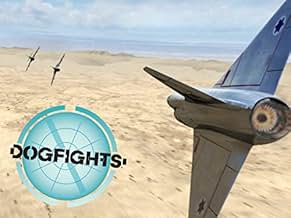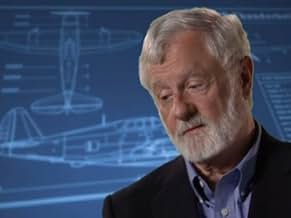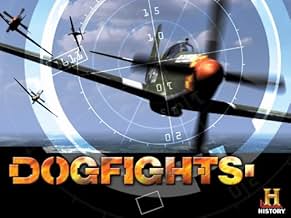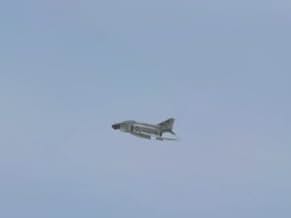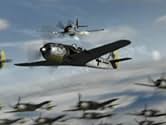Using modern computer animation, great aerial and modern naval battles are recreated. In the process, you learn about the history of military transportation technology, the tactics created a... Read allUsing modern computer animation, great aerial and modern naval battles are recreated. In the process, you learn about the history of military transportation technology, the tactics created and the people using them.Using modern computer animation, great aerial and modern naval battles are recreated. In the process, you learn about the history of military transportation technology, the tactics created and the people using them.
Browse episodes
Featured reviews
Although the series is high in technical proficiency and detail to re-animate air battles, there is an almost complete of historical balance. The focus of most chapters is on American aviators as if they were repeating the "Mariana's turkey shot" through the ages. Only a few chapters are devoted to Israeli or German and Japanese odds-and-ends (Me-163, kamikaze, etc.). Almost no mention is done of German, Russian, Japanese, Chinese and even North Vietnamese Aces that top all-time aerial combat Aces lists. They even neglect traditional allies as the British and the French. There are very detailed accounts of aerial battles from the "other guys" point of view that should be included to have a really "Historical balance" of aerial warfare.
It's a marvelous recreation of aerial combat from World War I through modern conflicts. I can't think of any computer-generated graphics (or whatever they're called) that have so convincingly recreated the aerobatics of combat aircraft and explained them so clearly. The aluminum surfaces glisten. The sun always seems to be shining, and when an airplane turns, the shadows on its wings turn with it. If the image is rearward, looking over a wing, you can see the elevators tip up and down slightly as the aircraft climbs or dives. Every detail on the aircraft seems exact. It's beautifully done. The graphics are nicely supplemented by newsreel and combat footage.
The narration takes us through the events, one by one, and sometime the participants tell us what they were thinking and what their intentions were. There is some sentiment, not much, in these recollections. The general layout of the conflict is described -- we learn why Mig Alley was so dangerous and why heavy bombers over Europe required fighter escort -- but the politics are absent. For each engagement, the principal characteristics of each airplane are described, and enemy aircraft get their just due.
One major observation and one minor. In the episodes I've seen, the victors were all Americans or American allies and the enemy lost, even when the opponent receives credit for being "an expert pilot." We sink the Bismark. We sink the Yamato. We shoot down every enemy airplane in sight, it seems, without losing any of our own. Why Rickenbacker and not von Richthofen, for instance? I wonder if it isn't somehow dangerous for younger and more impressionable viewers to watch a series like this in which we see a simulacrum of a video game in which we always win. The scientific studies of media presentations on real life have produced complex and mixed results. But I wonder. Is there a covert message? And, if so, is it: "Let's go to war and play Dogfight"?
One of the pilots interviewed mentions the need in a successful fighter pilot for "skill, aggressiveness, and the fighting spirit." I don't know what a fighting spirit is but fighter jocks seem to have the other two traits in spades. No power on earth could put me in a situation as dangerous as aerial combat. It takes a heap of persuasion to get me off the ground at all.
An ancillary note: A curious psychological study of fighter aces in the Korean war found a disproportionate number to be later-born children. There is weak support from other studies showing that later children are a little more open, agreeable, and maybe adventurous. Bomber pilots are more often first borns. George H. W. Bush has said that he preferred flying a Gruman Avenger with a three-man crew during World War II because he wanted the company. That puts him in the wrong slot, an anomaly, because he was the second son. He should have wanted to fly fighters but I'll give him a pass.
The narration takes us through the events, one by one, and sometime the participants tell us what they were thinking and what their intentions were. There is some sentiment, not much, in these recollections. The general layout of the conflict is described -- we learn why Mig Alley was so dangerous and why heavy bombers over Europe required fighter escort -- but the politics are absent. For each engagement, the principal characteristics of each airplane are described, and enemy aircraft get their just due.
One major observation and one minor. In the episodes I've seen, the victors were all Americans or American allies and the enemy lost, even when the opponent receives credit for being "an expert pilot." We sink the Bismark. We sink the Yamato. We shoot down every enemy airplane in sight, it seems, without losing any of our own. Why Rickenbacker and not von Richthofen, for instance? I wonder if it isn't somehow dangerous for younger and more impressionable viewers to watch a series like this in which we see a simulacrum of a video game in which we always win. The scientific studies of media presentations on real life have produced complex and mixed results. But I wonder. Is there a covert message? And, if so, is it: "Let's go to war and play Dogfight"?
One of the pilots interviewed mentions the need in a successful fighter pilot for "skill, aggressiveness, and the fighting spirit." I don't know what a fighting spirit is but fighter jocks seem to have the other two traits in spades. No power on earth could put me in a situation as dangerous as aerial combat. It takes a heap of persuasion to get me off the ground at all.
An ancillary note: A curious psychological study of fighter aces in the Korean war found a disproportionate number to be later-born children. There is weak support from other studies showing that later children are a little more open, agreeable, and maybe adventurous. Bomber pilots are more often first borns. George H. W. Bush has said that he preferred flying a Gruman Avenger with a three-man crew during World War II because he wanted the company. That puts him in the wrong slot, an anomaly, because he was the second son. He should have wanted to fly fighters but I'll give him a pass.
There should be no doubt that this is a highly biased and jingoistic American program, though, to be fair, it is primarily aimed at an American audience, the concept of American military supremacy ("Americans have never and will never lose a war.") being a large part of the American identity--like it or not. Overall, I regard this series as more entertainment than a collection of historically correct documentaries. If you read official reports of the engagements portrayed in these animations you will, in many cases, discover that some significant details have been omitted or down-played for various reasons. For instance, in the second season episode with Lou Luma, the American RCAF Mosquito pilot, they fail to mention the somewhat important fact that in his portrayed strafing mission (I agree, not really dogfighting) to the German aerodrome, his tail was nearly shot off by anti-aircraft fire (http://www.acesofww2.com/Canada/aces/luma.htm).
Americans are generally fond of emphasizing their role in various wars all the while down-playing or ignoring those of their allies, especially in cases where their allies'accomplishments were as good or better. Take for instance the clear anti-British and anti-Canadian (Canadians barely mentioned) bias shown by the celebrated, though increasingly discredited, American "historian" Stephen Ambrose particularly in his books concerning the D-Day landings. Also, consider the attitude that generated the American half-joke regarding the alternate meaning of the acronym of the American Expeditionary Force (AEF) in World War 1--"After England Fails". I believe the Australians also have some legitimate complaints regarding the overshadowing of their role early on in stopping the Japanese advances in New Guinea, and their overall achievements in the Pacific Theatre during WW2. Often, it seems that General MacArthur and the American media neglected to fully acknowledge the considerable efforts of the Australians under his command.
I think it is inevitable that if this show is to continue they will have to begin focusing more on the aerial exploits of non-American allies and possibly even enemies. There has been absolutely nothing about the Russians in World War 2 (or in any conflict) which is largely inexcusable considering the prime importance of battles on the Eastern Front from mid 1941 to the end of the war (the Americans may not want to recognize the longer and possibly greater role of the Soviet forces in destroying the German Reich), and very little concerning British Empire and French dogfighters in either war which I also think is a shame. I doubt that further depictions of "dogfights" of the Korean, Vietnam and Gulf wars or Israeli-Arab conflicts will be of sufficiently broad appeal as these are more controversial in terms of the motives behind the conflicts(Americans/Israelis won't necessarily be seen as the good guys) and in most of these cases the battles don't involve true dogfighting skills. Also, I think that they have already covered a lot (most?) of the territory regarding significant American dogfights of WW1 and WW2. Any additional focus on the same will make their biases undeniable.
The Americans were "Johnny come latelies" to both of the World Wars so, I don't know how much interest the producers of this show would have in aerial battles/campaigns before their entry, or in the early days following their entry into the wars, (e.g. in the Tunisian Campaign wherein they didn't do that well in the air or on the ground), but it is certainly something to hope for.
I await the third season which I assume is now in production.
Americans are generally fond of emphasizing their role in various wars all the while down-playing or ignoring those of their allies, especially in cases where their allies'accomplishments were as good or better. Take for instance the clear anti-British and anti-Canadian (Canadians barely mentioned) bias shown by the celebrated, though increasingly discredited, American "historian" Stephen Ambrose particularly in his books concerning the D-Day landings. Also, consider the attitude that generated the American half-joke regarding the alternate meaning of the acronym of the American Expeditionary Force (AEF) in World War 1--"After England Fails". I believe the Australians also have some legitimate complaints regarding the overshadowing of their role early on in stopping the Japanese advances in New Guinea, and their overall achievements in the Pacific Theatre during WW2. Often, it seems that General MacArthur and the American media neglected to fully acknowledge the considerable efforts of the Australians under his command.
I think it is inevitable that if this show is to continue they will have to begin focusing more on the aerial exploits of non-American allies and possibly even enemies. There has been absolutely nothing about the Russians in World War 2 (or in any conflict) which is largely inexcusable considering the prime importance of battles on the Eastern Front from mid 1941 to the end of the war (the Americans may not want to recognize the longer and possibly greater role of the Soviet forces in destroying the German Reich), and very little concerning British Empire and French dogfighters in either war which I also think is a shame. I doubt that further depictions of "dogfights" of the Korean, Vietnam and Gulf wars or Israeli-Arab conflicts will be of sufficiently broad appeal as these are more controversial in terms of the motives behind the conflicts(Americans/Israelis won't necessarily be seen as the good guys) and in most of these cases the battles don't involve true dogfighting skills. Also, I think that they have already covered a lot (most?) of the territory regarding significant American dogfights of WW1 and WW2. Any additional focus on the same will make their biases undeniable.
The Americans were "Johnny come latelies" to both of the World Wars so, I don't know how much interest the producers of this show would have in aerial battles/campaigns before their entry, or in the early days following their entry into the wars, (e.g. in the Tunisian Campaign wherein they didn't do that well in the air or on the ground), but it is certainly something to hope for.
I await the third season which I assume is now in production.
Great documentary series.
As the name suggests, a documentary series on aerial dogfights. Includes World War 1, World War 2, Korean War, Vietnam, 6 Day War, Yom Kippur and the two invasions of Iraq. Also has different forms of aerial combat, including naval and night-fighting.
Good narration, great CGI and good, relevant stories. Often shows a progression in tactics within the one episode.
About the only negative is that it is very US-centric. Most of the dogfights shown involve US pilots. No Red Baron (if I recall) and very little about the myriad of German Aces of WW2.
As the name suggests, a documentary series on aerial dogfights. Includes World War 1, World War 2, Korean War, Vietnam, 6 Day War, Yom Kippur and the two invasions of Iraq. Also has different forms of aerial combat, including naval and night-fighting.
Good narration, great CGI and good, relevant stories. Often shows a progression in tactics within the one episode.
About the only negative is that it is very US-centric. Most of the dogfights shown involve US pilots. No Red Baron (if I recall) and very little about the myriad of German Aces of WW2.
10bard-32
Dogfights is about the famous dogfights of World I to today. The show is based on a two-hour special that aired in late 2005. The show has chronicled the dogfights from World War II, Korea, and Vietnam. The most recent one was called Death of the Bismarck. It was about the British pilots who'd sunk the German battleship Bismarck in May 1941. There were also episodes about MiG Alley and Operation Bolo. The best episode was about the F6F Hellcat and the Japanese Zero. Another one was about the Flying Tigers. In some episodes, the actual veterans themselves, talk about their experiences. The animation is like a video game. There was an episode about the F-8 Crusader which was the last gunfighter. The F-8 was involved in a dogfight that lasted ten minutes. The longest dogfight in Vietnam. Operation Bolo was a successful attempt to lure the elusive MiG-21a into combat. The show has all the elements of a video game and this show is great.
Did you know
- How many seasons does Dogfights have?Powered by Alexa
Details
- Release date
- Country of origin
- Official site
- Language
- Also known as
- Párbaj az égen
- Production company
- See more company credits at IMDbPro
- Color
Contribute to this page
Suggest an edit or add missing content



